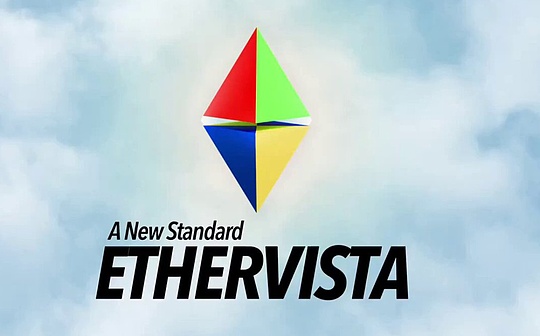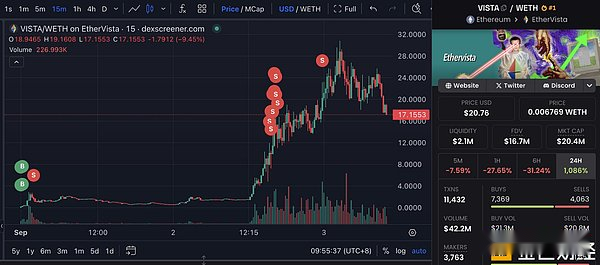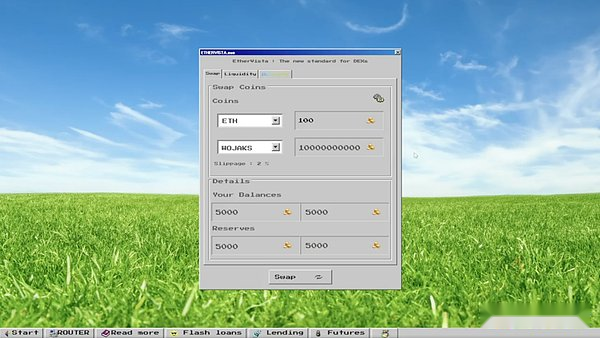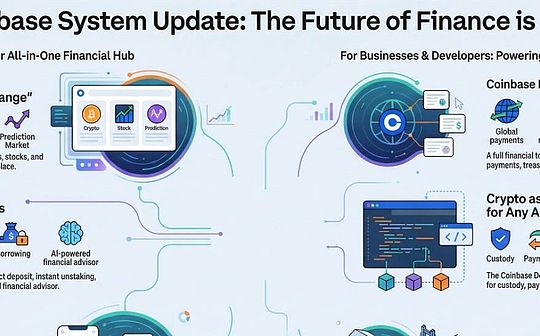
Author: REVC, Bitchain Vision
Foreword
According to data tracked by LOOKONCHAIN, the Frenulum.eth earned 274 ETH (about 696,700 US dollars) through the transaction Vista, with a return rate of 134 times.Frenulum.ETH costs only 2.05 ETH (about $ 5100) to buy 52,822 VISTA, and sells for 276.5 ETH (about 701,800 US dollars).At that time Vista’stwenty fourCalfering approaches1100%.
>
Ethervista is a new type of decentralized exchange (DEX) protocol, which aims to solve the disadvantages of existing AMM models (short -term token price speculation and liquidity provider insufficient inspiration).By introducing custom expense structures and new reward distribution mechanisms, Ethervista seek to promote the long -term growth and sustainability of blockchain projects.
Ethervista’smechanismCharacteristic (Brief version)),:,
-
Custom expenses: Ethervista uses custom expense structures paid only with native ETH, thereby achieving more flexible cost distribution.
-
Reward allocation: The agreement is based on the transaction volume of the distribution costs between liquidity providers and token founders to inspire long -term and practicality rather than short -term price behaviors.
-
Agreement fee: Part of the cost is allocated to the smart contract specified in the agreement, thereby supporting various DEFI applications and providing sustainable income for creators.
-
Lobricity provider reward: Lobricity providers have received rewards based on their contribution and total transaction volume.
-
Creator function: Creators can configure pool settings, define metadata, and even limit tokens transfer.
-
Vista token: Ethervista’s local currency has a supply limit and a tightening mechanism for currency.
Technical overview:
-
EULER (Reward Computing Unit): A series of incremental numbers for calculating its rewards based on the contribution of liquidity providers and the total transaction volume.
-
Expense distribution: The cost is allocated between the liquidity provider and the agreement according to the predefined variables.
-
Agreement cost distribution: The agreement cost can be assigned to smart contracts for various DEFI applications.
EthervistaDesign concept
Ethervista use onlyThe custom expense structure paid by the native ETH to achieve more flexible cost distribution.The current AMM standard is charged 0.3%of the tokens for each exchange.The Ethervista standard is the first setting of custom expenses paid only with native ETH.The cost is allocated to all liquidity providers and token founders in a specific pool, and each exchange is used to use a new mechanism, so that Ethervista can distribute rewards to millions of users at the least GAS cost.
>
The cost of the creator, as part of the agreement cost, can be assigned to smart contracts and treasury.Various use cases include automatic purchase, pledge rewards and many other DEFI applications.One of the key features of this model is that being a city merchant and founder benefit from the transaction volume rather than the token price, inspiring long -term rather than short -term price behaviors.Investors benefit from delayed liquidity removal mechanisms to prevent developers from “running” quickly.This method not only reduces the turbulent risk of the sudden market, but also increases the overall success rate of their investment.In the end, Ethervista will turn to constructing ETH-BTC-USDC pools to provide lightning loans that provide loans, futures and paids, and aims to become an integrated decentralized application.
protocolHow to distribute costs
As mentioned earlier, each exchange will charge the native ETH fee, which is allocated between liquidity providers and protocols.Each pool must initialize four UINT8 cost variables, corresponding to the cost distribution of trading transactions.These variables correspond to the USDC amount, and use the chain prophecy to calculate the corresponding ETH cost for each exchange.For example, the pool can initialize the cost of purchasing $ 10 and selling $ 15.The user decides to sell his tokens, and he must now pay an ETH worth $ 15 to the agreement and liquidity provider.
The smart contract distributed by the agreement can use this fee to increase the permanent locking liquidity, establish a rising reserve price for the token, and provide sustainable income for the creators.Liquidity providers can immediately receive the reward share collected by the exchange.
ProtocolcalculateWay
Ethervista maintains a promoter digital sequence called Euler’s amount on smart contracts.Each time the native ETH is transferred to a smart contract, these values are updated.The amount of each EULER amount is determined by the ratio of the previous EULER amount to the total supply of token (LP) of the current liquidity provider.The initial eULER amount is set to zero.
Mathematically, this update can be expressed as:
Fee Eulern = Eulern-1+ LP SUPPLY
Formula (1) As shown in the figure below, there is a corresponding sequence sequence:
Euler, euler2, euler3, euler … eulern}
>
Each provider is represented by a structure that the structure stores the LP holdings of each user and a variable called EULER0, which is named after the euler amount in the sequence.
Struct Provider {UINT256 1p;
uINT256 EULERO;};
>
As shown in the figure, the UINT256 number means that the user adds the latest euler amount in the liquidity sequence. It is assuming that the user decides to obtain a reward after 1,000 exchange.At that moment, the latest euler amount was Eulern+1000.The exact amount of the accumulated reward during this period is reward LP *(Eulern+1000-EULER0).
The formula in the figure above (2) This method assumes that the LP balance remains unchanged throughout the period.therefore,Whenever the provider takes any action, such as adding/removed liquidity, variable EULER0 will refresh to reflect the latest EULER amount in the sequence.This measure prevents liquidity providers from manipulating its own reward share.Therefore, it is recommended that liquidity providers always ask for rewards before adjusting the LP balance.LP tokens cannot be transferred unless it is destroyed or added/removed from liquidity.
The essence of this mathematical method is that it can accurately determine the share obtained by each user in each exchange, regardless of the continuous changes in the total supply volume of LP tokens caused by liquidity providers added or removed liquidityEssence
LiquidityPond configuration andexcitation
Those who initiate liquidity are the founders, and they will write access permissions to configure the pool settings.This includes determining pool costs, protocol address and metadata.The key parameter is the smart contract address assigned by the protocol.Although this parameter is available, the default is the address of the creator.Subsequently, the address received ETH from the protocol fee, and managed through the custom logic of smart contracts to achieve various DEFI applications that could not be achieved before the current AMM standard.This new income generation method will focus on the priority of short -term income and price behavior to the main priority consideration, long -term and practicality.
Creators can define metadata on their token definition chains, including website URL, logo, project description, social media handle, and chat URL.Users can access this information through Ethervista Dex’s resource manager window and other related details.This enables creators to effectively display their projects while ensuring that users can access verified security information, thereby reducing the risk of fishing attacks.Developers can use integrated launch windows to seamlessly start their projects on Ethervista.Ethervista also has the SuperChat function, which is a global real -time chat that directly integrates to the DEX platform. Users can quickly exchange information.Access Super Chat is based on grades, depending on the number of Vista tokens held by users.
Creators can also choose to give up their writing access rights and effectively lock all settings permanently.It is hoped that their token transactions are limited to the creators of Ethervista. The ERC20 TransferFrom function can be limited to the Ethervista router address.
In addition to the cost of pools and agreement, there is a fixed cost of $ 1 to the continuous development of Ethervista Dex and SVISTA.This fee will be used to implement Lightning loans, futures and loan functions without handling fees, as well as supporting potential CEX listing and marketing activities.
VistaToken economy model
SVISTA is the native currency of DEX, with a total supply of 1 million tokens.Ethervista is a composite composite narrowing token.The Ethervista protocol’s smart contract implements a chain process. Among them, each destruction incident not only reduces the amount of circulation, but also gradually increases the base price of the tokens.This effect is maintained by continuous acquisition and destroying tokens, and these tokens are funded by the cost generated by the agreement in each transaction.Therefore, VISTA’s mechanism uses the combination of activities with supply with supply and reserve price growth, and acts as hedging of inflation, thereby strengthening the value of VISTA in each transaction and promoting sustainable growth and scarcity.
>
according toEthervistaThe latest data,,The total supply of 2.17%of VISTA has been permanent repurchase and destroyedEssence
Ethervista Future Plan:
-
Expansion of the fund pool: Ethervista plans to provide borrowing, futures and no cost Lightning loans.
-
Integration with CEX: Ethervista aims to be listed on a centralized exchange.
summary
Ethervista’s design mainly focuses on repurchase and lock warehouses. The transaction fee is charged and divorced to the liquidity provider, which plays a role in reducing the pressure. However, the premise of dividend is based on the agreement.Emotions are not enough to support the value of agreement.At present, the DEFI protocol must not only focus on the optimization of the price curve formula, but also combine the innovation of scenes and asset levels.In addition, developers of Ethervista pools can reserve tokens, and investors should be judged carefully when choosing.The risk of the contract that has not been open source also needs to be vigilant.
Because the liquidity cannot be traded freely within the lock -up period, if the holder is sold in large quantities after unlocking, it may lead to the exhaustion of liquidity, which will cause the risk of a sharp decline in pricesEssence
Based on the latest data from DexScreener,,EthervistaThe market value of circulation fell1740$ 10,000,,Tokentwenty fourHourly increase76%, 24Hours transaction volume is over5300$ 10,000EssenceThe transaction volume exceeds its market value, showing that the project has a high popularity and frequent change rate,,You also need to be alert to market volatility.







